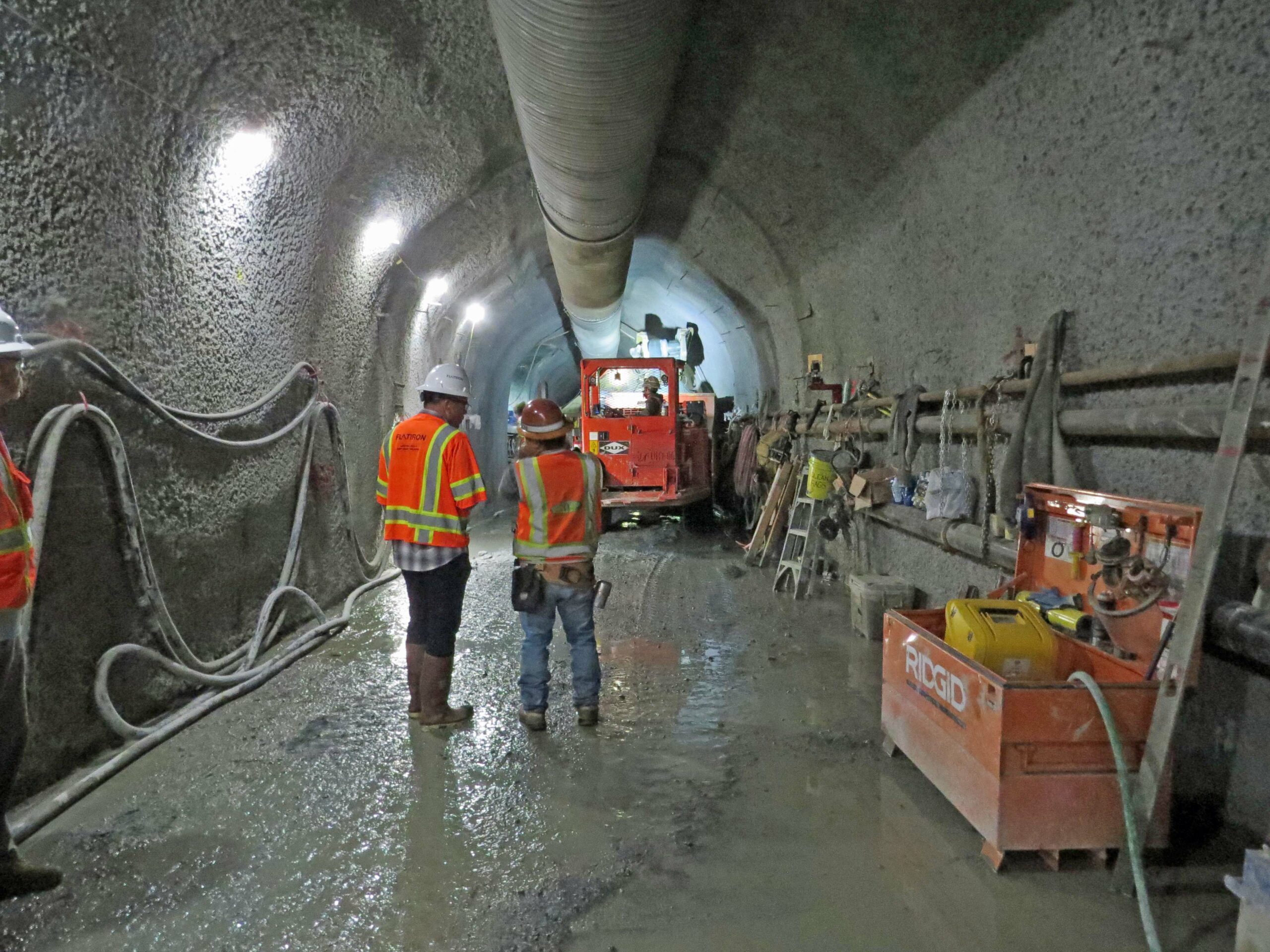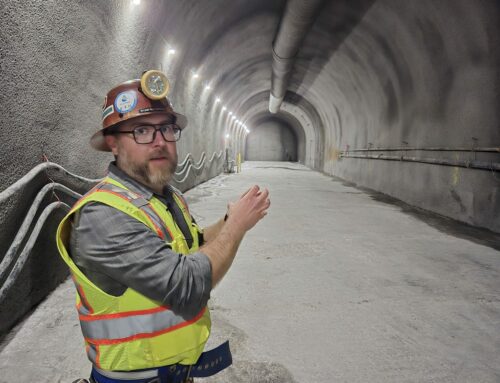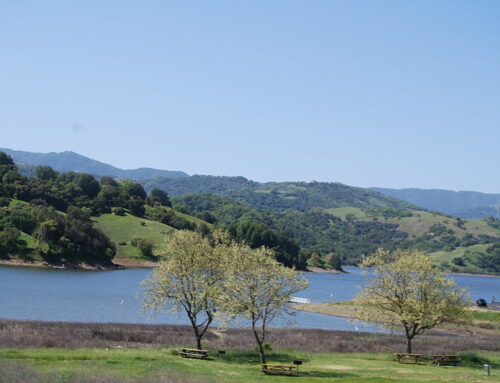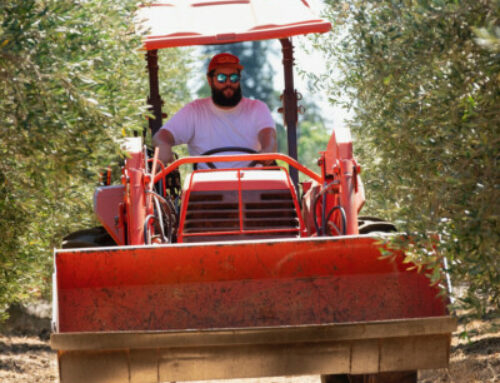Team of miners now two-thirds done in excavation of 2,000-foot-long project

Workers watch the excavation inside the Valley Water tunnel that’s part of the $44 million Upper Llagas Creek Flood Protection Project. Photo by Marty Cheek
By Marty Cheek
Deep under the streets of a quiet neighborhood west of downtown Morgan Hill, a crew of 10 miners have been spending the past six months excavating hundreds of tons of rock in the construction of a lengthy tunnel designed to save property from flooding.
As of mid-July, the workers from the Antioch-based Drill Tech have dug about 1,350 feet into the earth from a starting point near the intersection of Main and Hale avenues. The entire tunnel will stretch about 2,000 feet to reach the exit point where workers are now working on building cement box culverts. The completion of the big dig is expected in fall, said Dale Hata, a project manager for the Antioch-based Drill Tech, the firm hired by Valley Water to bore the tunnel.
“We’re looking at finishing tunnel excavation probably in September or October,” he said. “It’s going to come out of the hill on Del Monte (Avenue) just north of Dunne (Avenue).”
To watch a YouTube video of the tunnel tour, pleaser click HERE
The underground channel will serve as a vital part of Valley Water’s second phase of the $44-million Upper Llagas Creek Flood Protection Project started in October 2021. The entire project will create 13.9 miles of improvements including underground piping and tunnels to control flooding in the South Valley region during major storms.
Overall, the excavation process has gone smoothly thanks to the blessings of the hill’s geology, Hata said.
“The soil conditions are a little bit easier than we anticipated so that has really helped us to tunnel and put us a little bit ahead of schedule,” he said. “Overall, we’ve still got 650 feet to go and there are still going to be some challenges with ground conditions ahead.”
Scott Hensler, principal project manager for construction management consultant Mott Macdonald, considers the Nob Hill tunnel a “medium-sized job”
“It’s going well. There’s always issues that need to be resolved and we’re resolving those issues as we go along. I think their tunneling is going excellent,” he said of Drill Tech. “They’re doing a great job.”
The miners work from 7 a.m. to 6:30 p.m. Monday through Friday. They also work every other Saturday, followed by a two-day weekend every other week. Many on the mining crew live far away so stay in Morgan Hill for the work days and then go home to spend time with their families during the weekend.
“We have a really good crew out here,” Hata said. “In the tunneling industry, the guys tend to go from job to job and I think we all understand that it’s very rare to have a tunneling project inside a major city. The guys that we have here are really dedicated to the project. It’s really pretty much the A Team out here. That’s a big reason why the tunneling aspect of the project is going so well.”
After a 10-minute safety training session, a reporter joined several other people on a hard-hat tour to see first-hand the progress of the tunnel. Led by Hata, they strolled down a slope for about 100 feet and passed through the rounded entrance about 16-feet high. The walk was through mud the consistency of pancake batter that covered the floor. As they progressed farther, they had to gingerly walk through silty water that covered shoes.
Halfway through the underground journey, a debris hauling truck rolled from around a bend and the group stood with their backs to the sidewall for a minute until it passed on its way to the excavation site.
After 10 minutes of venturing deep into the heart of the hill, the group reached the excavation site. Directly above them on top of a hundred or so feet of earth was the Nob Hill water tank. The scene might have been out of Dante’s “Inferno” with the silhouettes of men laboring in a hot and humid work environment made even more hellish with the dust and loud mechanical noise generated by the devilish excavation machine. Under the glare of bright lights burning in eerie fog created from the mist of water used to control the dust, the machine screamed nonstop as it grinded its teeth attached to a revolving drum against the end wall, breaking the hard rock into gravel-like chunks called “muck.” The broken debris dropped onto a conveyor belt that then dumped it into the bed of a large hauler truck. When full, the driver would take the muck through the tunnel to unload it in a large pile just outside the tunnel entrance.
The tunnel is designed to follow the city streets above, said Jeff Wells, the area operations manager for Flatiron, which is overseeing the construction. Valley Water used the street right-aways the city of Morgan Hill already owns to avoid the hassle of dealing with homeowners if they dug beneath houses. And added benefit: if the engineers had used the traditional surface routing, they would have had to drill multiple holes in the streets with steel tubes and grout it to hold the utilities in place so they wouldn’t sink into the tunnel.
Although there have been some complaints about the noise during the day from some nearby residents, Valley Water has tried to reduce the impact, including building a gauntlet of two tall steel sound walls around the entrance.
“We’re trying to minimize impact with the local neighbors and working with them to try to come up with ideas with the Valley Water team to try to minimize those impacts,” Wells said.
Valley Water started the second phase of the $44-million Upper Llagas Creek Flood Protection Project in October. The entire project took about 60 years to be planned, approved and funded, explained Valley Water Director John Varela, representing District 1, which includes South County. Phase 2A of the project is estimated to be completed in 2025.
“The completion of this project is so important to the entire region of South County but most importantly to the citizens and residents of Morgan Hill,” he said. “The true litmus test is going to be when the project is completed and we have the first heavy rains like we had in 2017, how flooding is going to be prevented. I’m confident this is the right thing to do.”






